The announcement by Honda Malaysia that it was discontinuing the much loved Honda Jazz was met with shock, sadness and a little anger on the social media sphere.
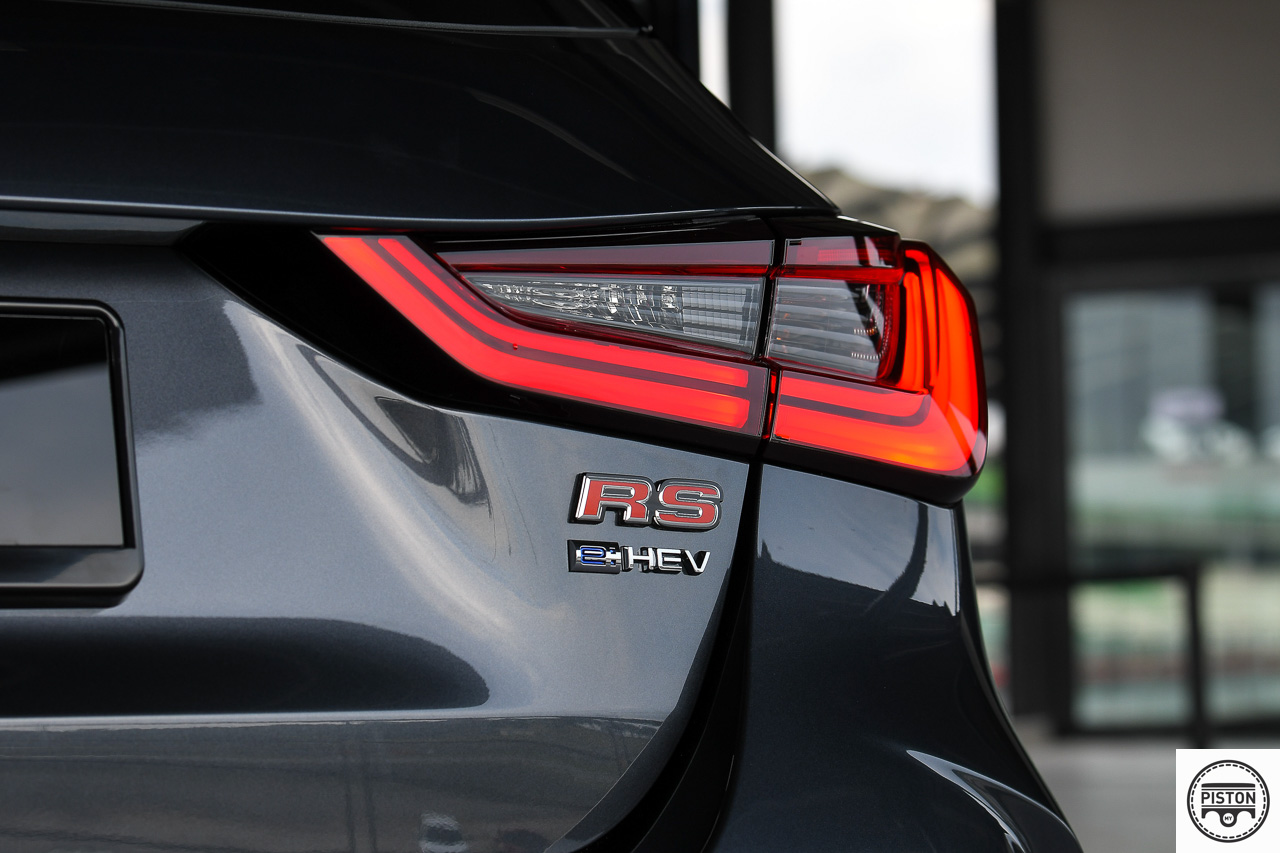
Since its introduction in 2003, Honda Malaysia has sold over 120,000 units, showing that Malaysians really loved the Jazz.
It is undoubtedly true that the Jazz provided the perfect answer to those looking to commute in an urban environment and to some extent, even inter state travel.
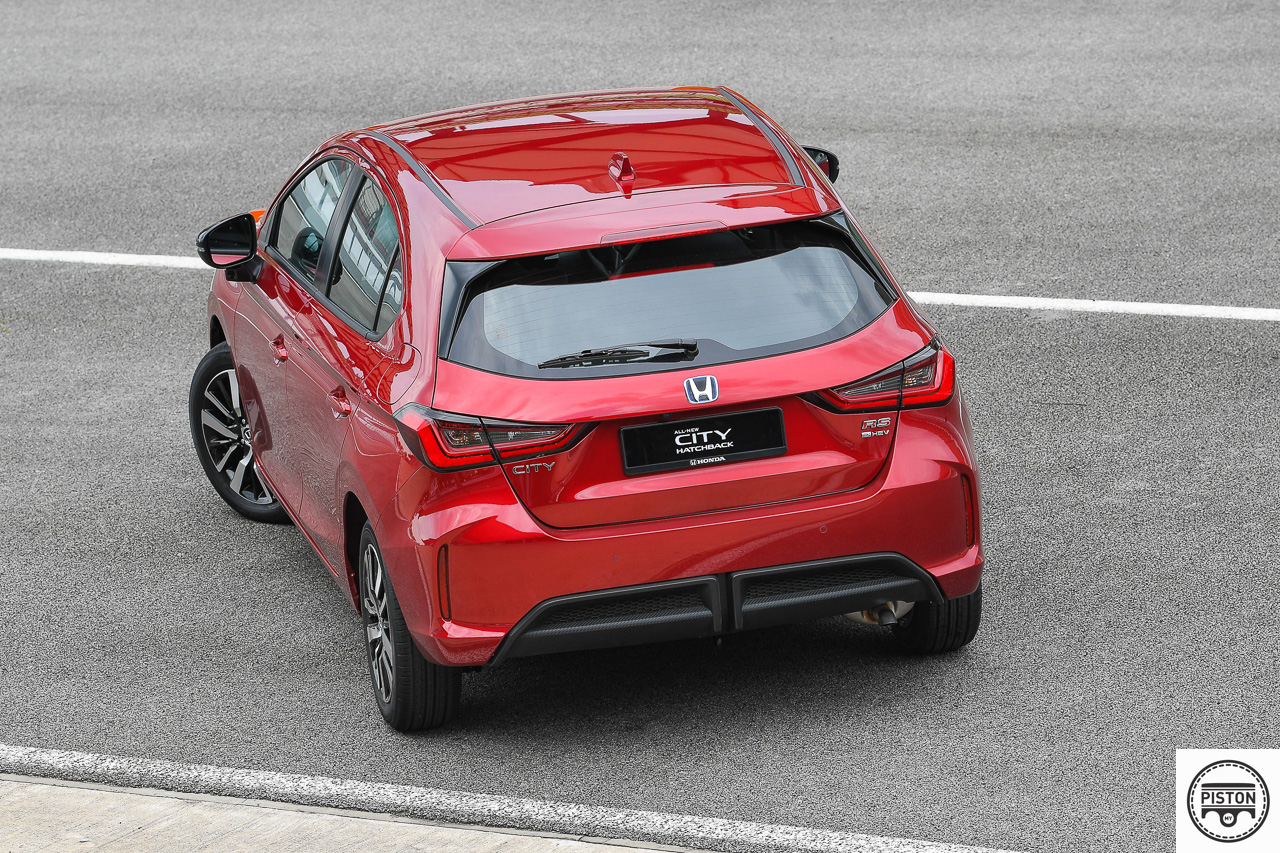
Back in university days, those from regular families would perhaps arrive in a Proton, or opt for public transport. Those from better to do families would arrive in a Jazz. It had that kind of appeal. It not only provided mobility solutions, but defined segments of the community as well.
Enter the all-new Honda City hatchback.
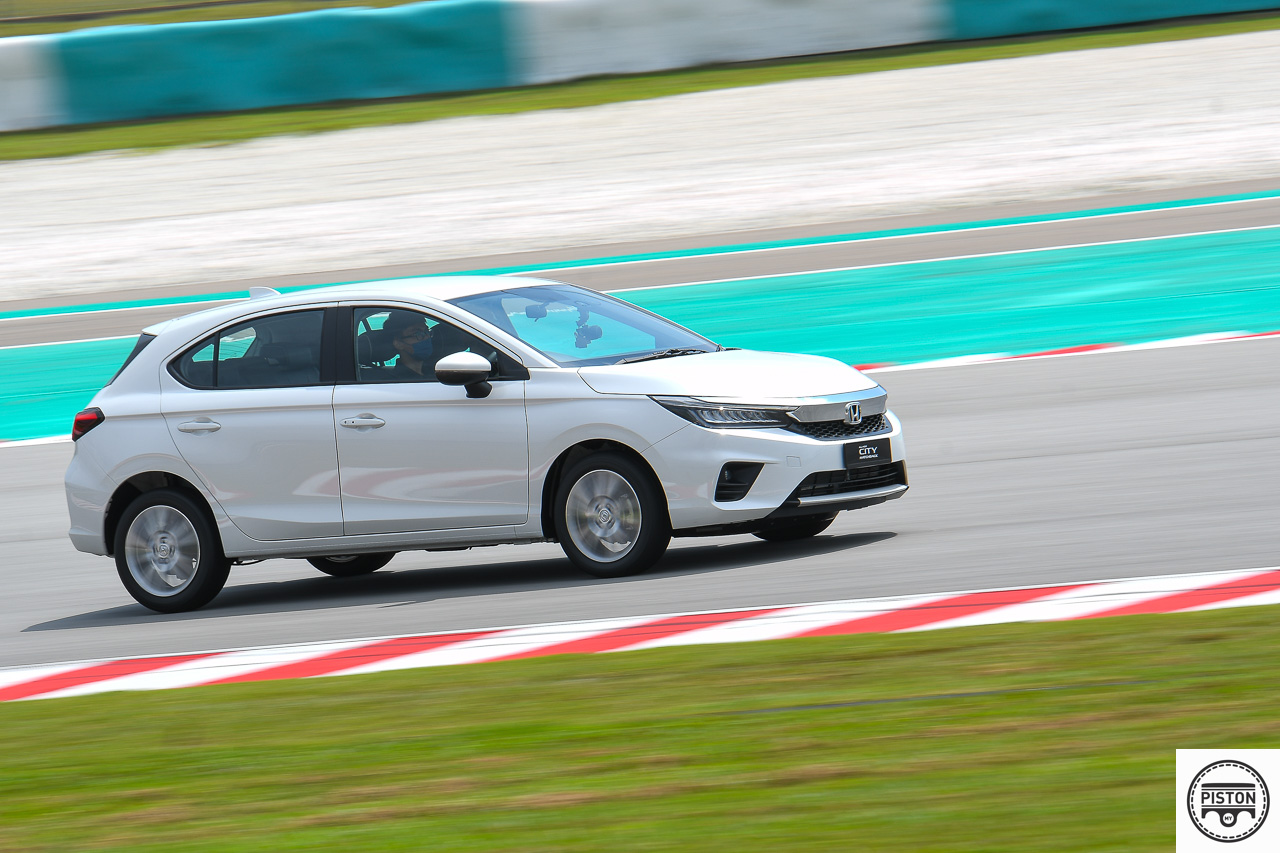
What was Honda thinking you might say. Why discontinue a product that has obviously been selling well and offered bang for the buck?
The Jazz does live on in spirit with the new City hatchback. Simply put, the all-new Honda City hatchback builds on the already proven formula of the Jazz, but switches it up a notch or two more to make an already good product even better.
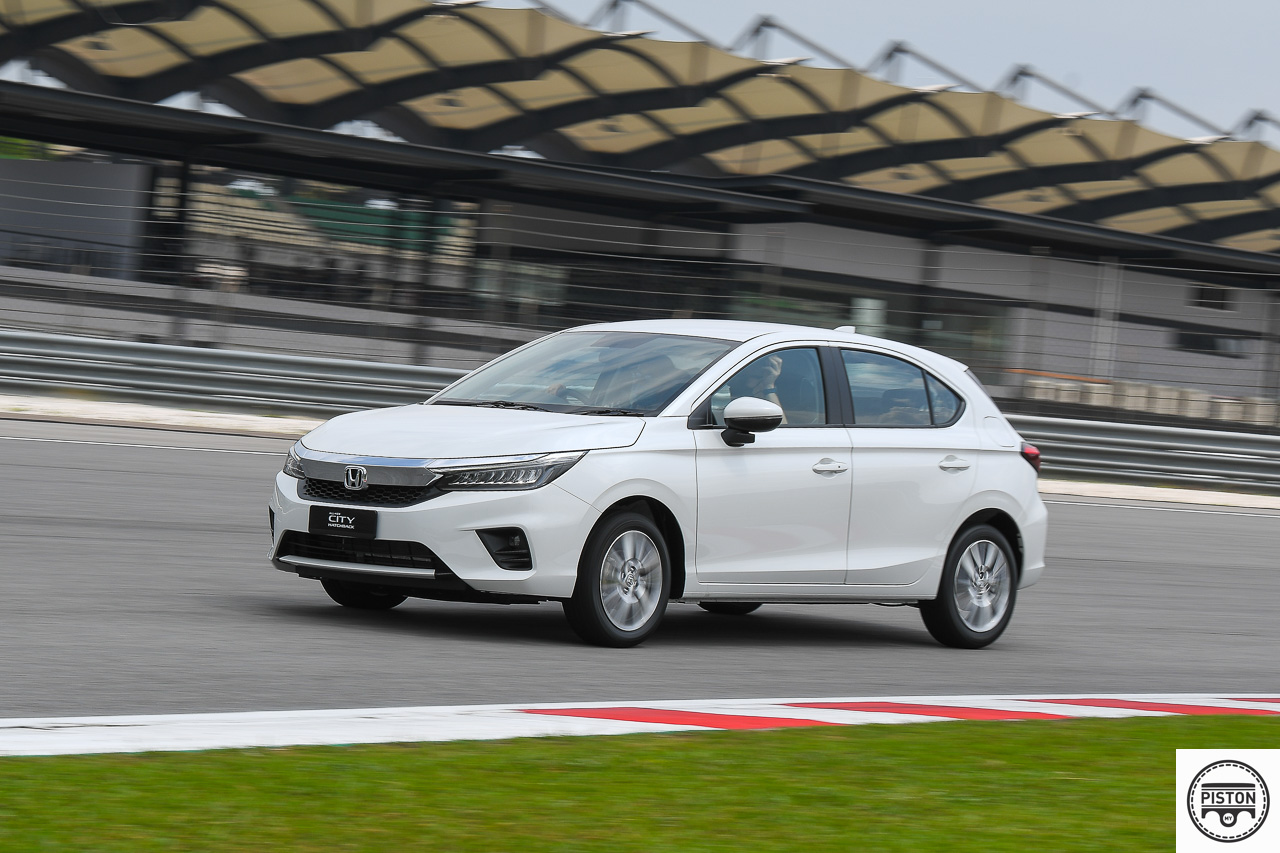
We got to drive the new City hatchback at the Sepang International Circuit (SIC).
Before you think that the car would undoubtedly perform well around the smooth tarmac of Sepang, the venue was chosen because it offers privacy as the car has not been officially launched in Malaysia as yet.
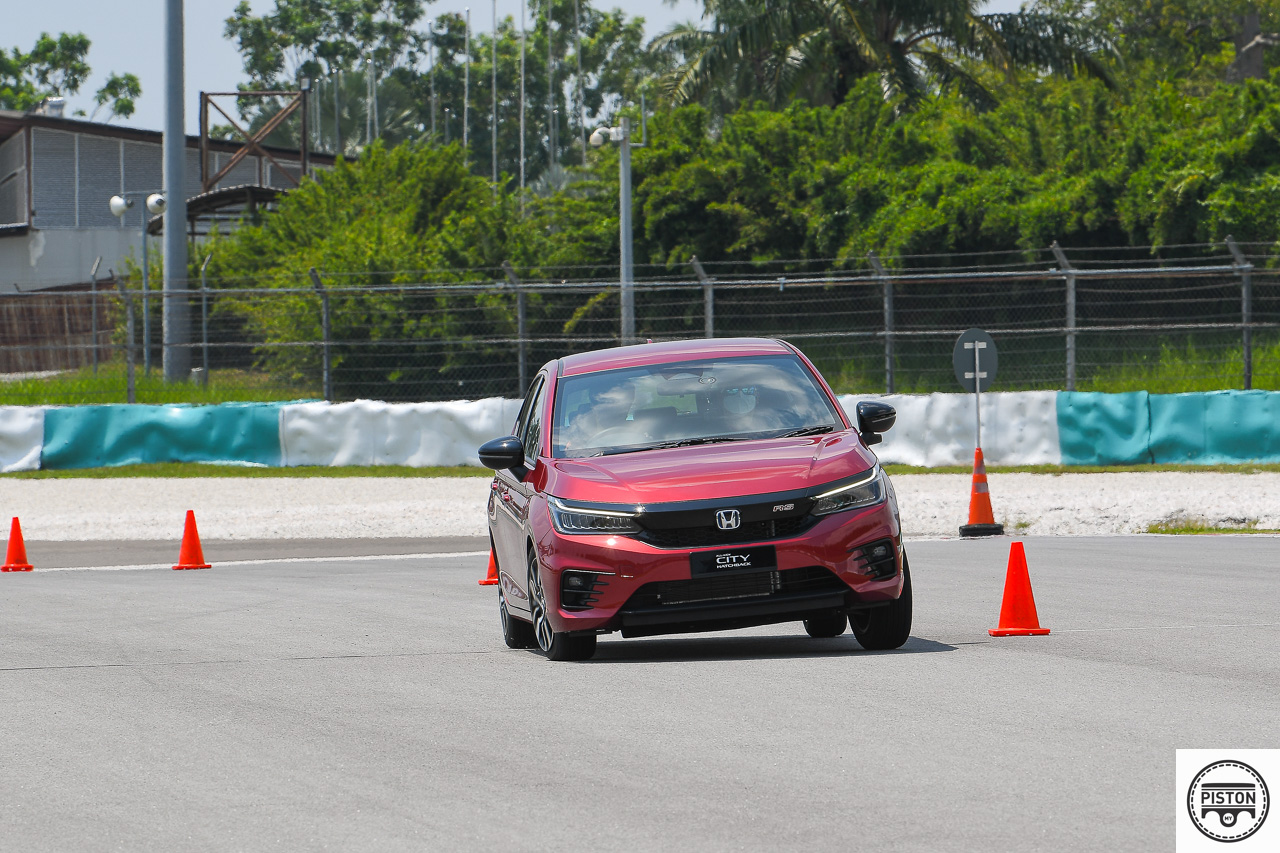
And we were limited to 110km/h, tested the acceleration, the handling in a slalom course, and the high-tech Honda Sensing technology. Simply put, SIC was transformed to offer as close to real world conditions as possible.
And of course, we also got to spend time in a competitor car, just to see how much better the City hatchback really is. And of course, the new City is leaps and bounds better than the competitor that shall not be named.
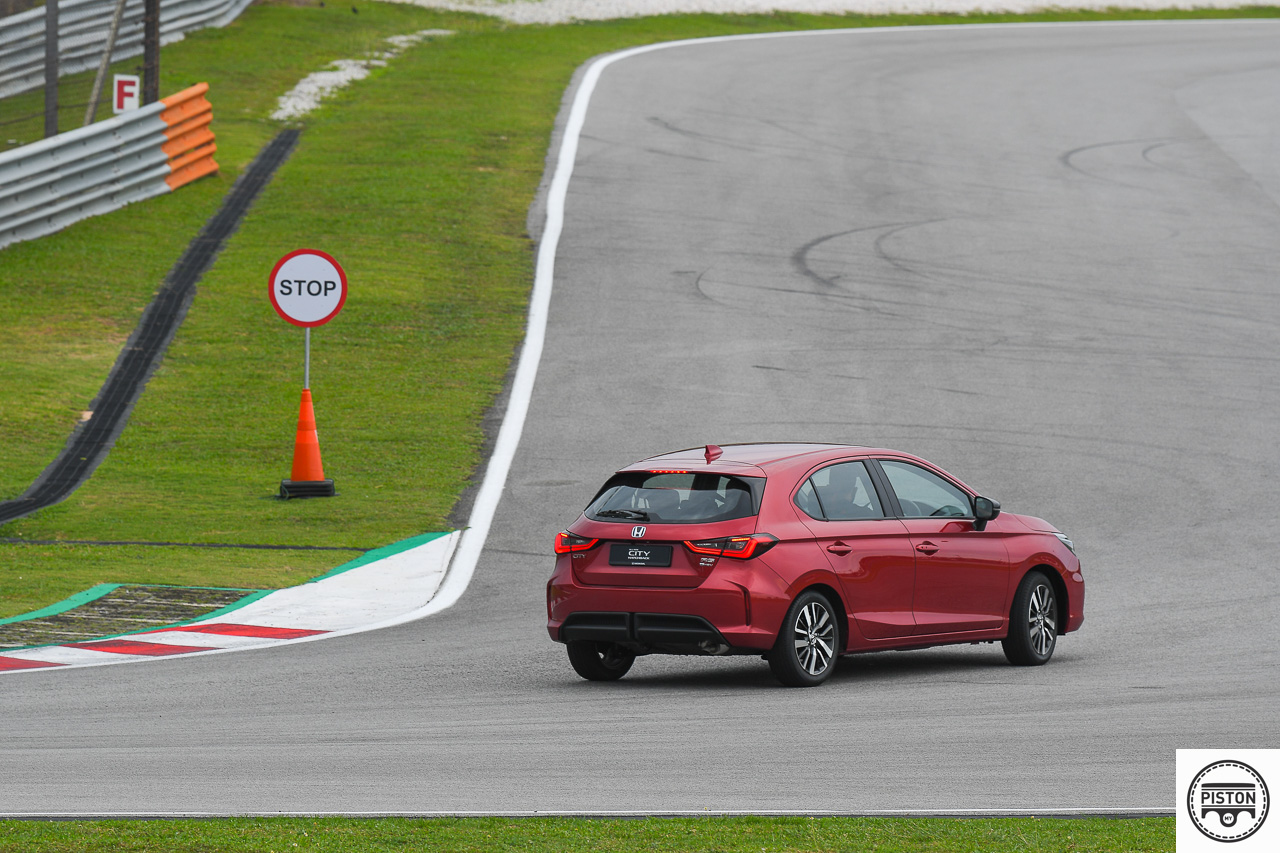
We cannot show you photos of the interior of the new City hatchback due to an ongoing embargo, but let’s just say that owners of the current Honda City sedan would find some refreshing updates.
The Honda Sensing technology is also integrated into the City hatchback and performs the same while offering the same slew of technologies like Adaptive Cruise Control, Collision Mitigation Braking System, Forward Collision Warning, Lane Keep Assist System, Road Departure Mitigation, Lane Departure Warning and Auto High Beam.
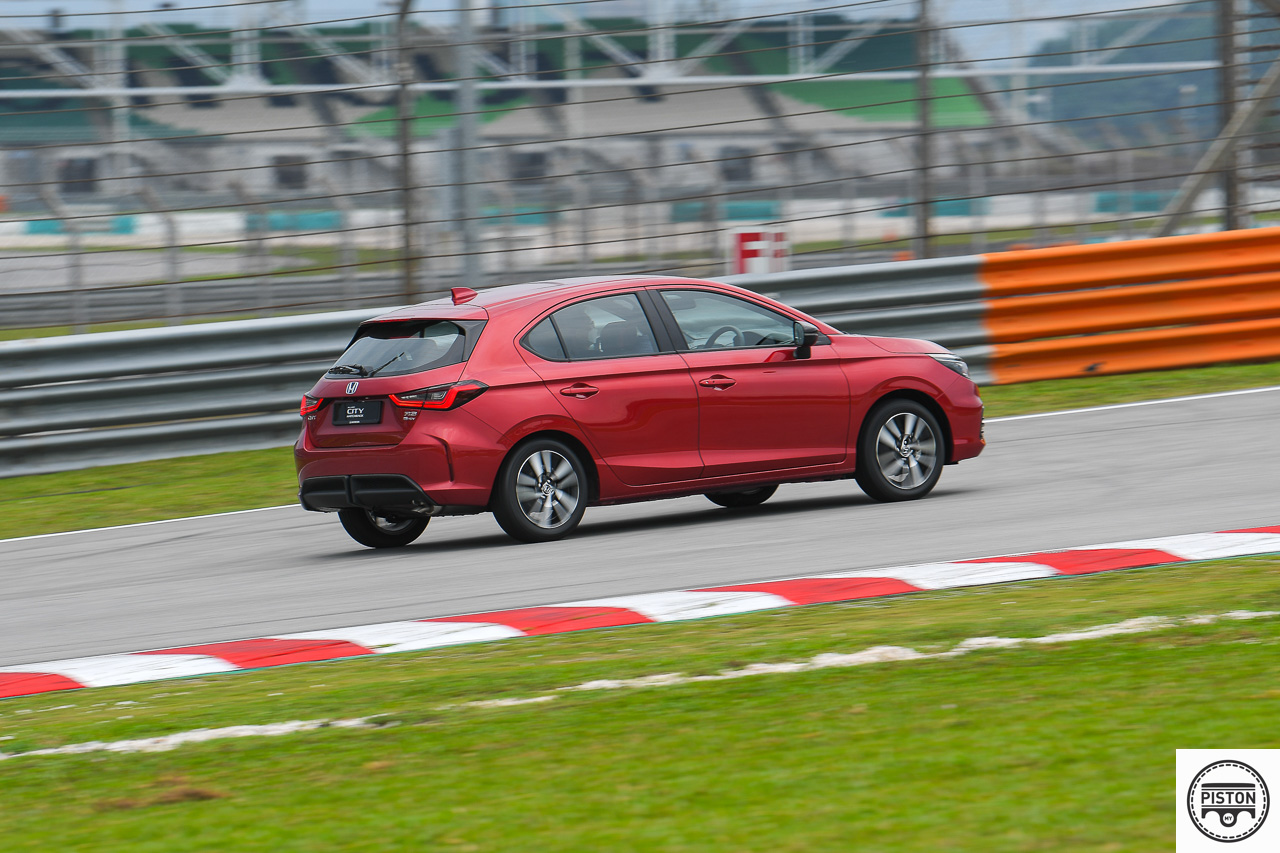
But what is new for the City hatchback is the addition of the Honda LaneWatch system (for the RS and V variant only). This is not new tech as we have seen it before in the CRV, HRV, Civic and Accord.
But it now uses a wide angle lens that offers a more complete view of whatever is on your left. We tried it and can confirm that it works great. Honda Malaysia had a CRV follow us on the left to prove its effectiveness.
Then came the acceleration test at turn 10 of SIC, which is an uphill climb.
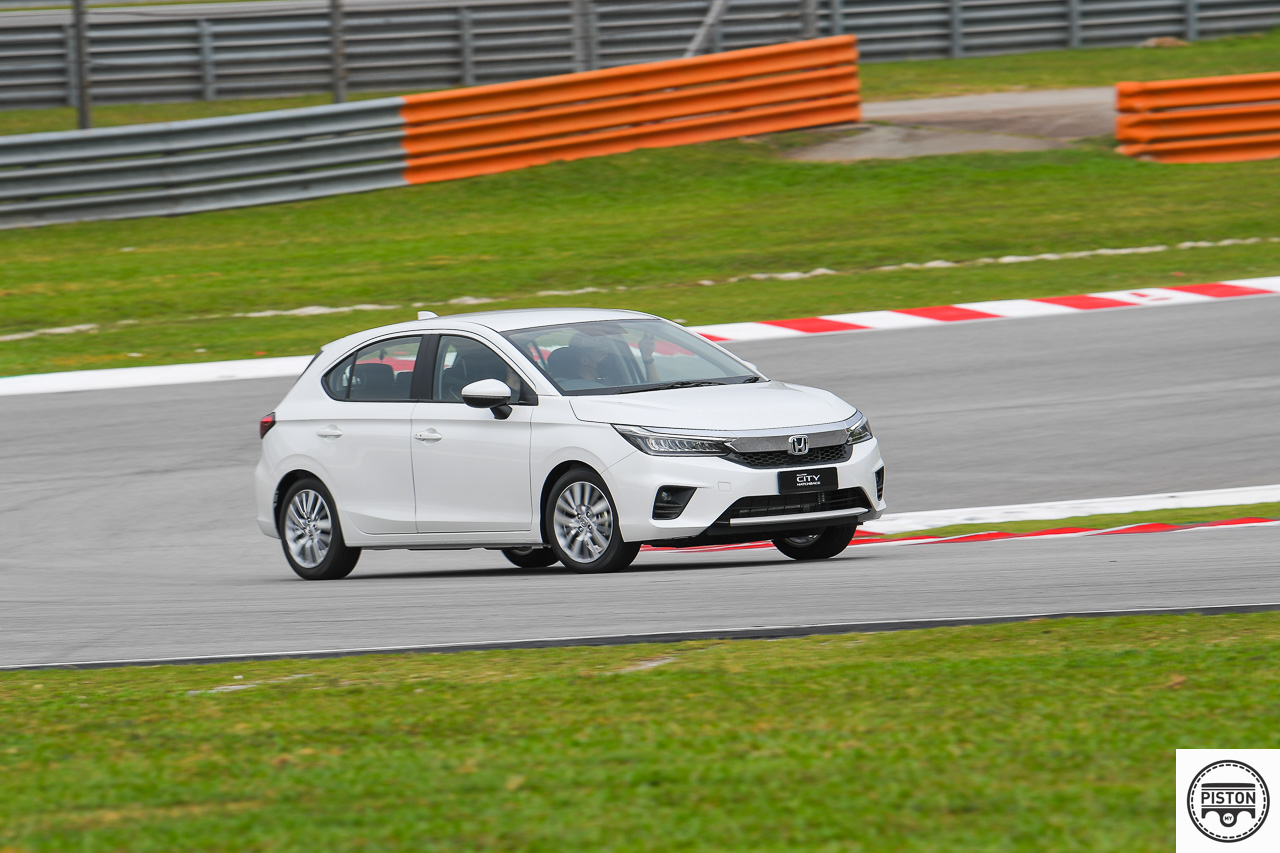
The competitor of another Japanese make suffered here with the engine droning and struggling to lay down power. There was no shove into the seat, just a lot of waiting around for power to be delivered to the tarmac.
We first tried the V-Spec petrol variant, and that too had a little droning, but power was laid down more urgently.
The petrol variant is powered by a 1.5-litre engine producing 118hp and 145Nm of torque. Which is decent for daily commutes and highway driving.
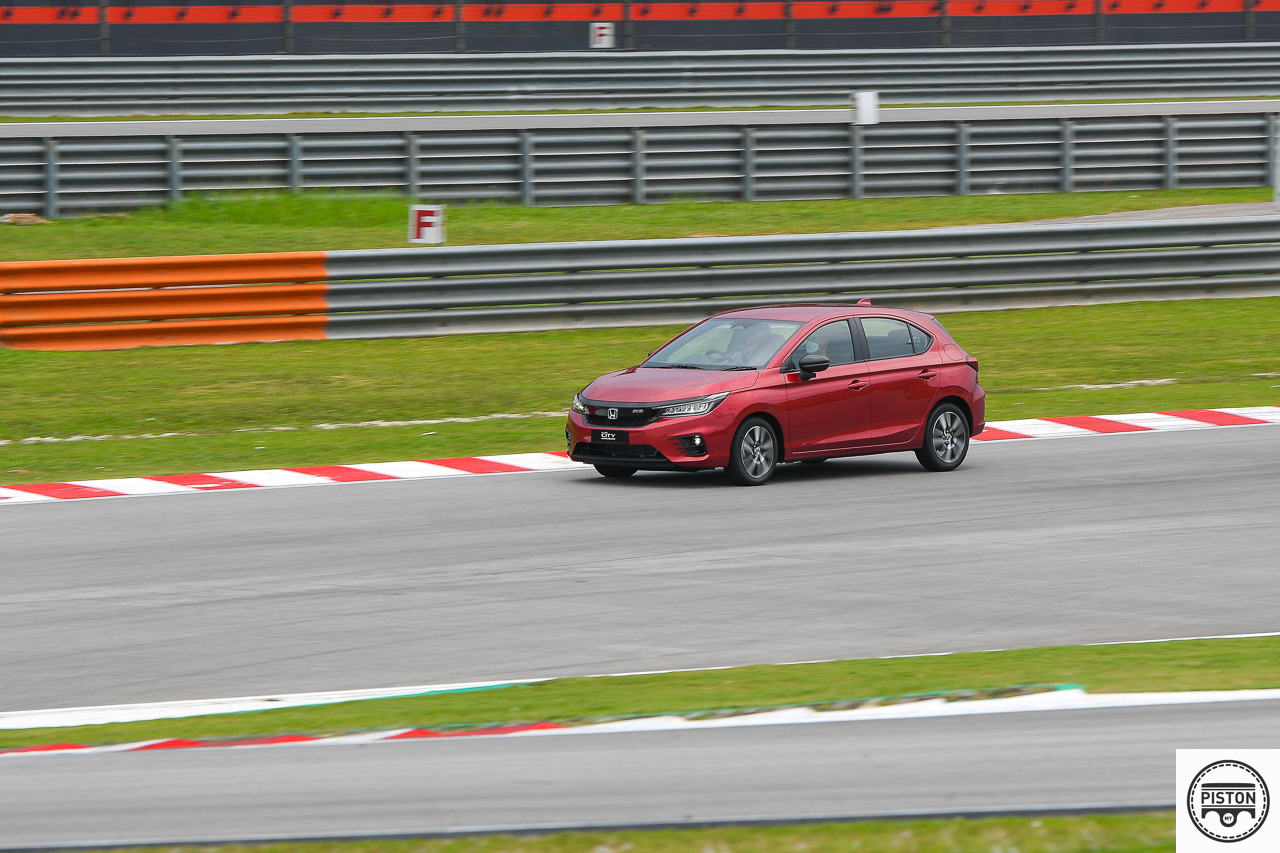
The RS though was something else.
It too is powered by a 1.5-litre engine but this offers something called Sports Intelligent Muti-Mode Drive (i-MMD). This tech utilises two electric motors that are located at each side of the front wheels that are electrified by a battery pack located at the rear of the car.
We all know what a combustion engine paired with electric motors can do. This has resulted in a powertrain that offers a class leading 253Nm of torque.
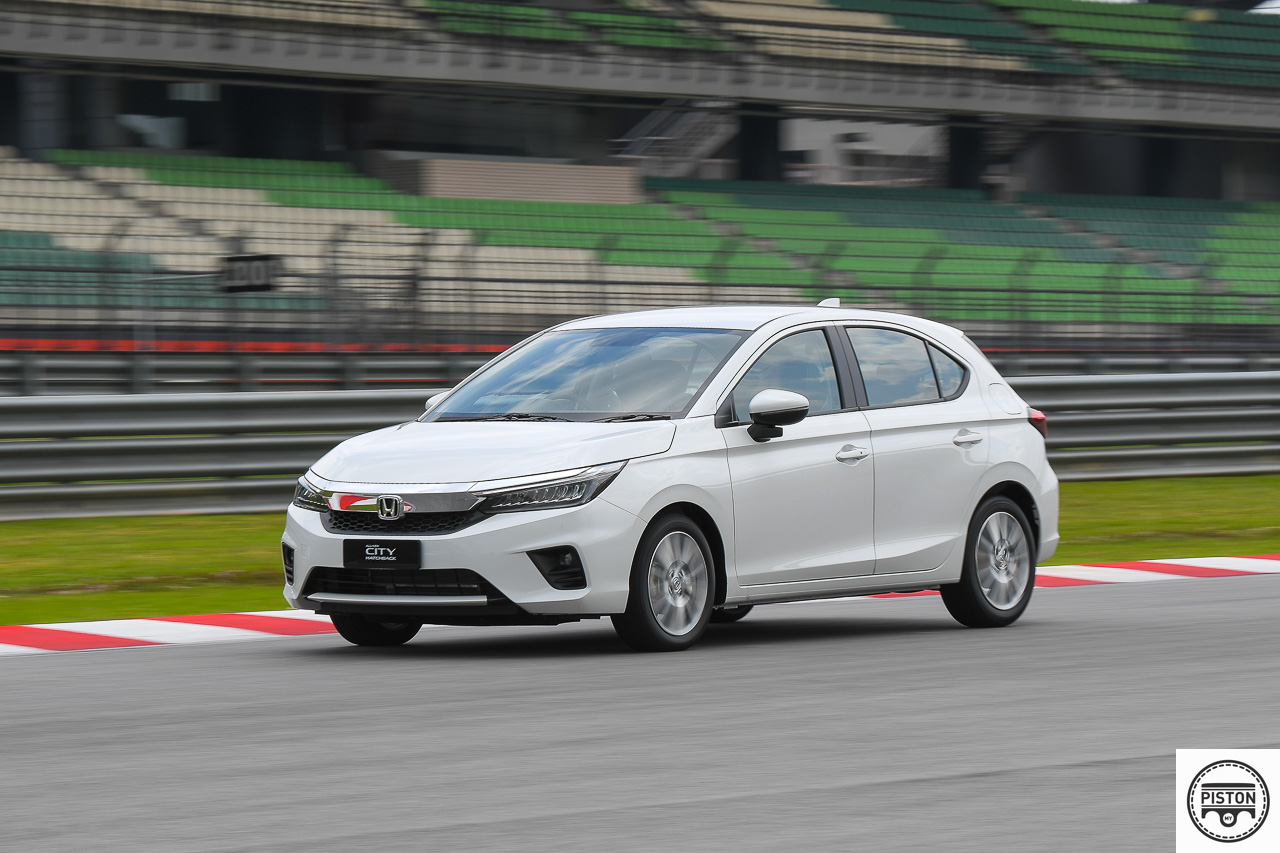
Honda Malaysia will not reveal the combined power figure but instead will only tell us that the City RS hatchback produces 106hp. This horsepower figures are from the electric motors alone, and not from the engine. Now imagine what a combined power figure might be like.
Back at turn 10 of SIC, the City RS hatchback had that reassuring shove into the seat, a testament to its power, and power delivery was linear with no loss during shifts.
For a car to replace the much loved Jazz, it had to offer versatility and spaciousness. And the City hatchback has a lot of that because it offers something call ULTRA seats – a feature first seen in the Jazz.
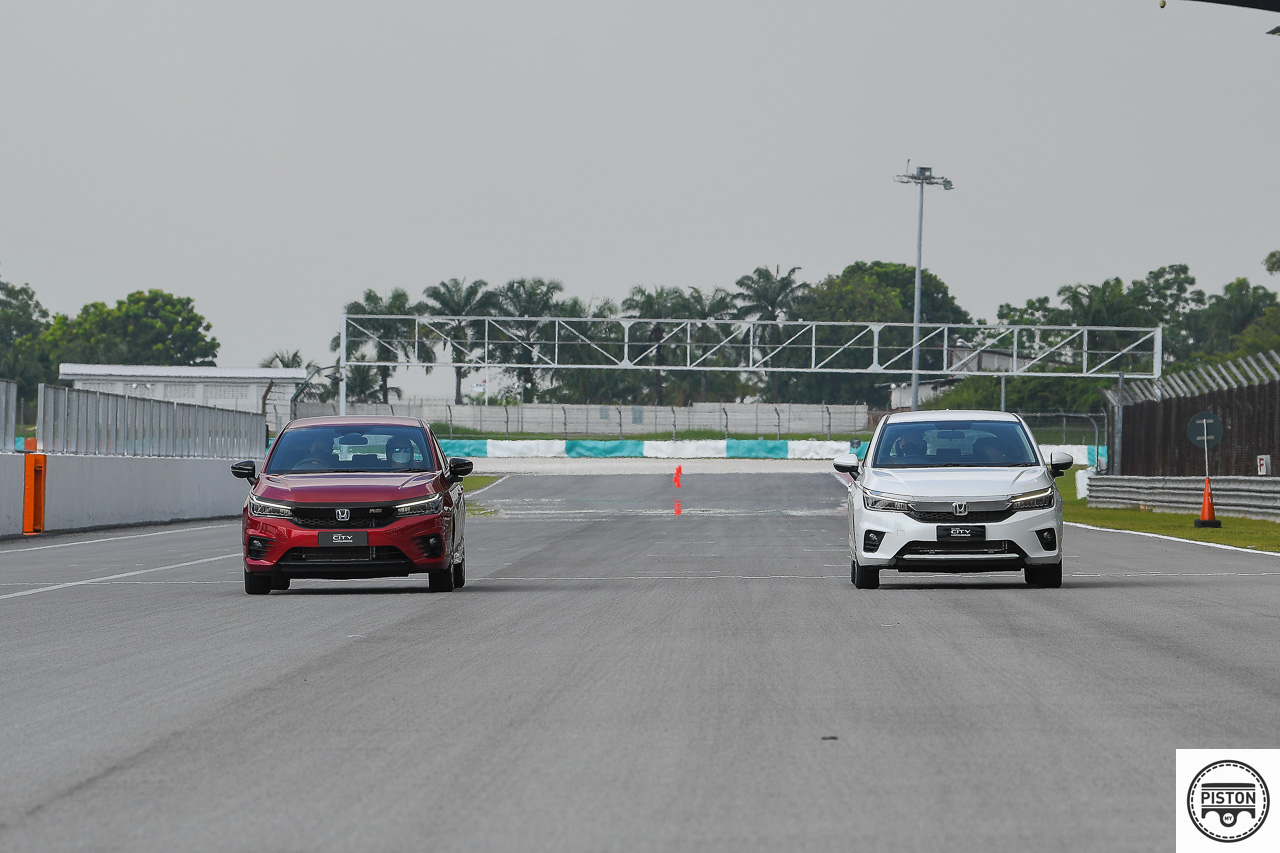
Ultra Seats offer different configurations to keep up with the many demands of life. There’s the Utility mode which folds the rear seats flat to expand on the boot space. A rather regular feature.
Then there is the Long mode that folds just one part of the rear seat as well as the front passenger seat to store long items – a regular feature as well.
After that there is the Tall mode and this is where things get interesting because in this mode you can fold the rear seats upwards to create more floor space. This is to store tall items, and you don’t see this feature in other cars.
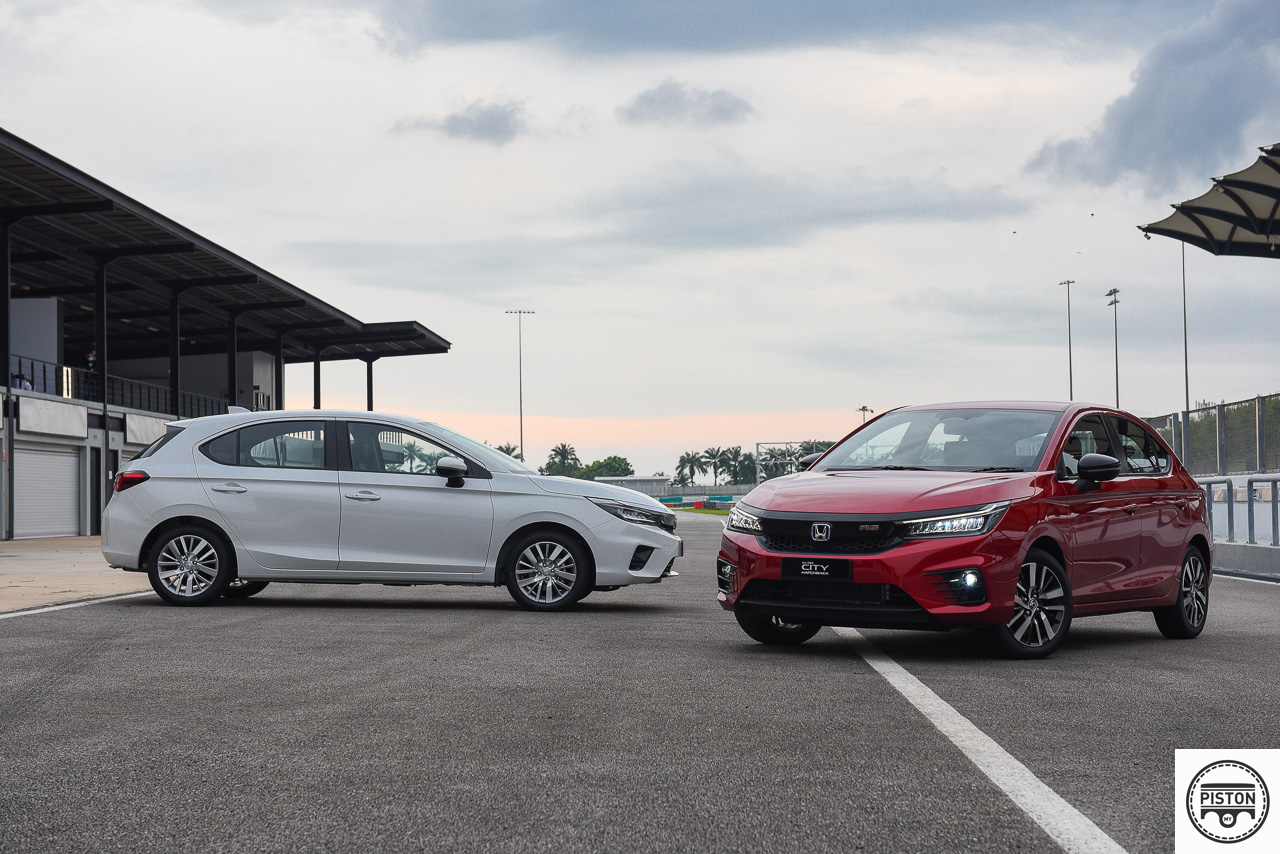
What is even better is the Refresh mode which turns the interior of the City hatchback into two small beds. You read that right – you can turn the interior into two beds! This is perfect for those with an active outdoor lifestyle as you can go camping and such with the City hatchback.
So you see, the City hatchback continues the legacy of the Jazz and takes it up a few notches. In fact it sprinkles in some refinement and quality as well because the interior feels brilliant and well thought out. Quality is fantastic as well.
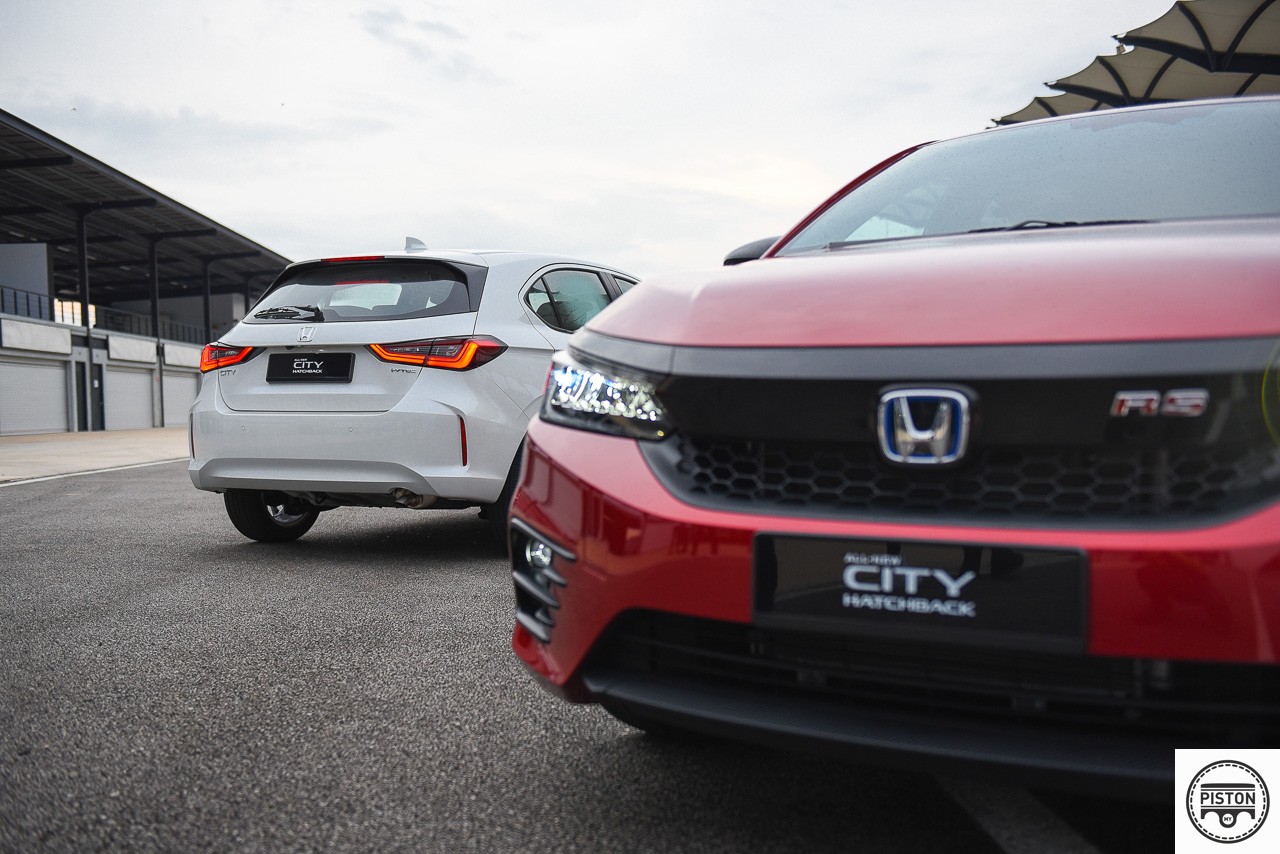
There is no indication on pricing as yet as Honda Malaysia will only disclose that once it is officially launched. But bookings are already open, and if you want something that is good for the family and can do just about anything that life demands except for race camels in a desert, then give the new Honda City hatchback a good hard look. As for pricing, don’t expect it to be too far off the price of the sedan.
Besides the new 718 Cayman GT4 RS, Porsche will also unveil another model at the coming LA Auto Show this weekend. It’s the track-only GT4 RS Clubsport which is for those who want to go racing with a Cayman. Not being street-legal has allowed the engineers to take development to the limit in extracting maximum performance.
The most significant change is the 4-litre 6-cylinder boxer engine, a high-revving powerplant which comes from the 911 GT3 Cup racing car. Installed in the GT4 RS Clubsport, it develops 500 ps – 75 ps more than the previous GT4 Clubsport model.
In addition to many upgraded details, the focus in developing the new 718 Cayman GT4 RS Clubsport was on further improving overall performance. The standard 7-speed dual-clutch transmission (PDK) fitted to the car now uses all 7 forward gears, rather than 6, and all gears have shorter ratios than in the previous model.
Depending on the track and series-specific regulations, the new racing is said to be able to achieve lap times that are over 2% quicker than the previous model. The homologated vehicle is track-ready straight from the factory.
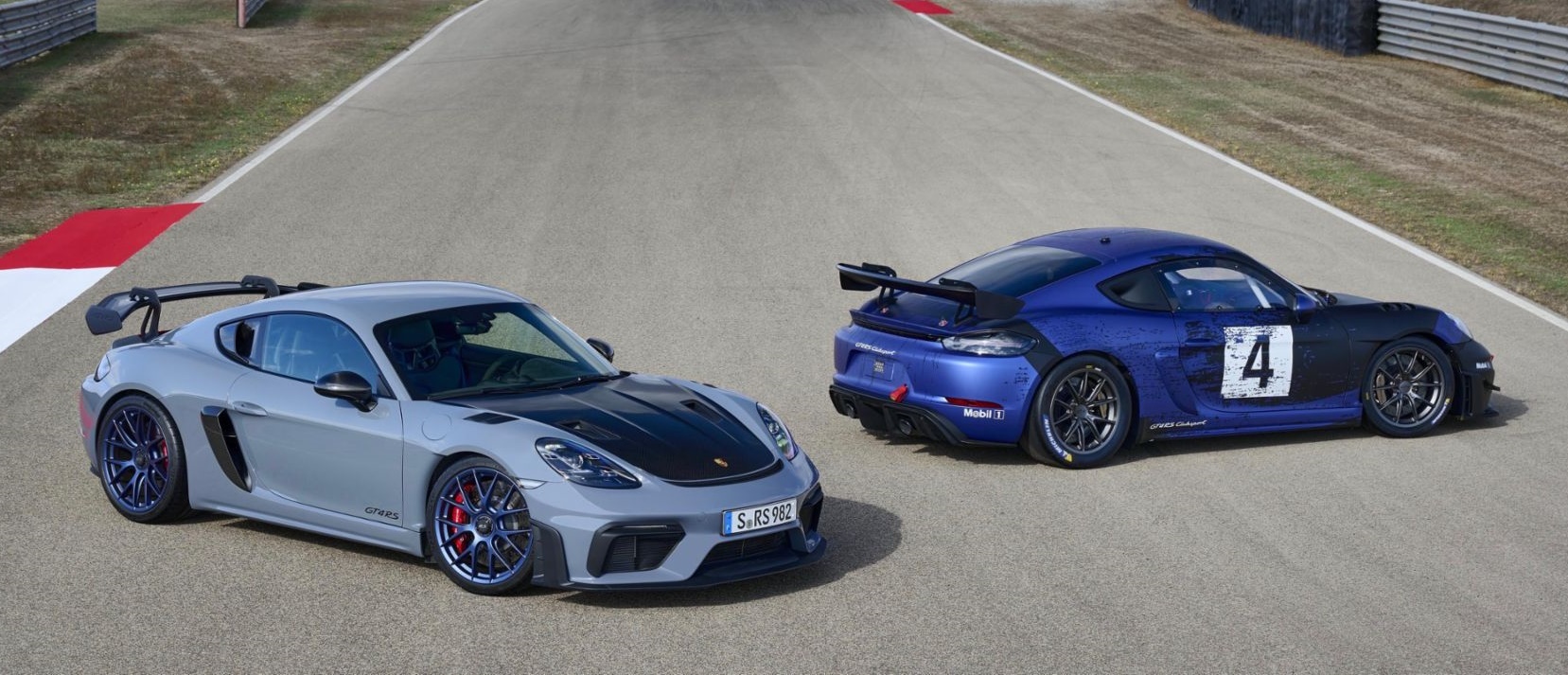
3 years of GT4 Clubsport experience
“We have incorporated our experience of the last 3 years of running the previous GT4 Clubsport as well as customer wishes into the development of the new car,“ said Michael Dreiser, Manager of Sales and Distribution at Porsche Motorsport. “Faster lap times combined with a further improvement in driveability offer our customers a competitive product for the upcoming racing seasons in GT4 class racing competitions around the world.“
Porsche began offering the Cayman GT4 Clubsport of the 981 generation in 2016, entering into this new customer racing format early with a competitive car. A total of 421 units were built prior to 2018. The next generation model, which was based on the 718 Cayman GT4, debuted in 2019. It was also an extremely success car, with around 500 units produced to date.
One of the reasons for the strong demand for these vehicles is due to the low running costs. The use of well-proven series production technology combined with racing-specific components significantly reduces the costs for customer teams.
Improved competitiveness
The latest 718 Cayman GT4 RS Clubsport, priced at US$229,000 (about RM957,000) continues this tradition with better competitiveness. The more powerful engine is almost 18% more powerful than the 3.8 litre engine that was used in the previous model. Thanks to an optimized air intake, maximum power is achieved at 8,300 rpm – 800 rpm higher than before. The new engine, which can spin up to 9,000 rpm, develops 465 Nm at 6,000 rpm instead of the previous 425 Nm at 6,600 rpm. This gives the driver a much wider usable speed band, which makes driving the car much easier for pro-racers and amateur drivers alike.
The Porsche Stability Management System (PSM) is designed specifically for motorsports and includes a switch for traction control, ABS and an updated stability control system.
Modifications to the chassis have also improved the handling. The damper technology has been totally revised to achieve an optimized vehicle responsiveness and better body control. This has had a significant impact on the overall performance of the vehicle and handling. Upgrades include the use of 2-way adjustable shock absorbers with improved characteristics, in addition to adjustable sword-type anti-roll bars front and rear.
The height of the vehicle, along with wheel camber and toe are also adjustable. Furthermore, 3 different spring rates for front and rear axles are now available. Special NACA ducts in the bonnet are designed to direct the airflow more efficiently to the large racing braking system fitted with 380 mm steel brake discs.
Aerodynamics ensure precise handling
Aerodynamics plan an important role in having precise and controllable handling, and this aspect has been given a lot of attention. Front dive planes and an extended front spoiler lip increase downforce at the front axle, with the wheelarch vents in the wings (inspired by the 911 GT3 R) and air curtains specifically designed to calm the air turbulence around the front wheels. The fully enclosed underbody optimizes airflow to the diffuser at the rear of the car.
The previous 718 Cayman GT4 Clubsport was the first ever production racing car to use body parts made of renewable natural-fibre composite material. In the case of the new GT4 RS Clubsport, even more extensive use of this material is made as a whole. In addition to the doors and the rear wing, the bonnet, the wings, the aerodynamic components at the front end and the steering wheel are now made of this material.
The use of this flax-based fibre as an alternative to carbonfibre composite material can now be tested in motorsports for its use in road cars. Porsche has been using motorsports as a test bed for technology, processes and materials potentially capable of being used in road cars for over 70 years now.
Race-ready from factory door
The GT4 RS Clubsport is equipped to enable the owner to go racing with minimum work done. It has a welded-in roll cage and fore and aft adjustable Recaro racing seat, along with 2023-compliant 6-point racing safety harnesses and safety nets as well as a fire extinguisher system. There is also a built-in air jack system with 3 jacks for quick wheel-changes. The new safety foam on the driver’s side meets the international requirements of the SRO racing series.
The FT3 safety fuel cell can take up to 115 litres of fuel, making it suitable for endurance racing. Additionally, Porsche offers two different exhaust systems, allowing the GT4 RS Clubsport to compete at tracks with stricter noise limits. The car is also prepared for the later addition of homologated headlights or openings in the bonnet for fast refueling to enable the car to be converted quickly for nighttime endurance racing.
Porsche Mission R is ‘just a vision’ – but it is ready to race too
The Integra is back, presented by the Acura brand for the global reveal of the ‘prototype’ model. Like Type R, the Integra name gets enthusiasts’ pulse racing and it is particularly respected in America. While the Integra in other markets was sold by the Honda brand, the original was the model that helped launch the Acura brand in America in 1986.
No more 2-door coupe design
Unlike earlier Integras which were 2-door models, the coupe is now a 5-door fastback design. Designed in Japan, the new Integra’s exterior styling (finished in NSX Yellow for the prototype) features a dramatically sloping roofline and tailgate, giving it a distinct coupe-like road presence.
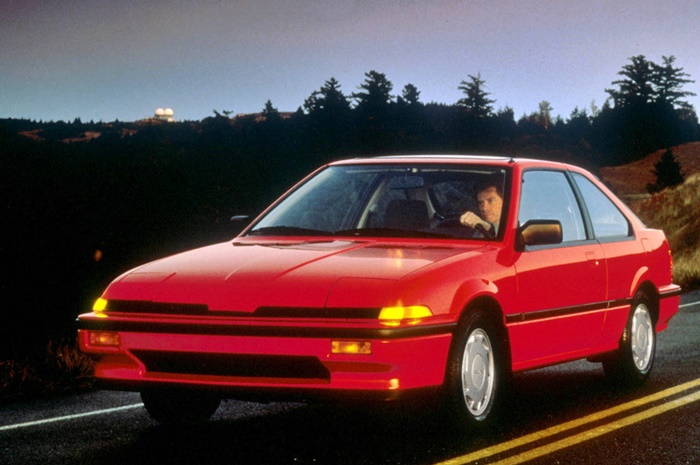
The fifth-generation model displays trademark cues such as the embossed Integra name under the driver’s side headlight and passenger’s side taillight. First seen on the Type S Concept, Acura’s new frameless Diamond Pentagon grille gives the Integra front a purposeful and sporty character. Its unique lighting signature is updated with the ‘Chicane’ LED daytime running lights positioned above the Integra’s JewelEye LED headlights, giving an even more dramatic appearance.
Appropriately, the rear wheelarches are muscular, while an aggressive rear fascia with dual-exhaust finishers emphasizes the Integra’s wide track. Inspired by previous Integra models, the distinctive rear styling features wide, single-piece taillights with the matching ‘Chicane’ light signature.
Behind the Integra Prototype’s matte-finish 19-inch split-5 spoke wheels are oversized Brembo high-performance brakes with colour-keyed Indy Yellow calipers, providing plenty of stopping power while also having an aggressive look.
First factory turbocharged Integra
This will be the first-ever factory-turbocharged Integra, powered by a high-output 1.5-litre VTEC engine of the latest Civic Si. Enthusiasts will be happy to note that a manual transmission with 6 speeds will still be available, and there will also be a limited-slip differential.
The fifth-generation model will be built in America and priced at around US$30,000 (about RM125,000) when it appears in showrooms next year.
“The Integra is one of the most iconic models in Acura’s history,” said Jon Ikeda, Vice-President and Acura Brand Officer. “This new Integra, will continue to deliver on the original’s unique aspirational yet attainable market position, with emotional performance and style, combined with the versatility and utility sought after by today’s buyers.”
2020 Honda Civic Type R drivers can see performance data with new LogR app (w/VIDEO)
Although Audi can lay claim to having been dominant in the World Rally Championship (WRC) with its Group B Quattro rallycar, the German carmaker has never taken up the challenge of the Dakar Rally. But for the 2022 edition of the world’s toughest off-road event, Audi will be there and it will be the first car manufacturer to use an electrified drivetrain to compete for overall victory against conventionally-powered competitors.
The car that the Audi Sport team will use will be the RS Q e-tron and it’s been undergoing an intensive test program since the first prototype fired up in July this year. After overcoming the challenges posed by the pandemic, the engineers now face the special challenges that the characteristics of the Dakar Rally present. The annual marathon event lasts 2 weeks and the daily stages are up to 800 kms in length. “That’s a very long distance,” said Andreas Roos who is responsible for the Dakar project at Audi Sport. “What we are trying to do has never been done before. This is the ultimate challenge for an electric drivetrain.”
Because there are no charging opportunities in the desert, Audi has chosen an innovative charging concept. On board of the car is the highly efficient TFSI engine from the DTM. It is part of an energy-converter that charges the high-voltage battery while driving. Since the combustion engine is operated in the particularly efficient range of between 4,500 and 6,000 rpm, the specific consumption is well below 200 grams per kWh.
A third motor-generator unit (MGU) is part of the energy converter and serves to recharge the high-voltage battery while driving. In addition, energy is recuperated during braking. The battery weighs about 370 kgs and has a capacity of around 50 kWh. The maximum system power of the e-drivetrain is 500 kW. The electric drivetrain offers many advantages. The electric motors can be controlled extremely precisely and can thus ensure good drivability. In addition, braking energy can be recovered.
The most recent testing was done in Morocco as crews Mattias Ekstrom/Emil Bergkvist, Stephane Peterhansel/Edouard Boulanger and Carlos Sainz/Lucas Cruz took turns in the cockpit of the RS Q e-tron which can now handle daily off-road distances in testing equalling the length of a Dakar stage.
The entire team is focusing its energy on continuing the development under the toughest conditions,” said Arnau Niubo, Head of Test Engineering. “It was impressive how important findings flowed back to the factory from Morocco at a daily pace. As a result, our 3 rallycars currently under construction for the Dakar Rally will have the latest technical status. At the same time, logistical preparations are in full swing.”
The three crews subjected the prototype to a total of more than 2,500 kms over the toughest terrain. The various system tests included the engineers imposing artificially high temperatures on the RS Q e-tron. Peterhansel drove the rallycar through a dry riverbed with the cooling air intakes deliberately taped off to simulate high outside temperatures – and the electric drive didn’t fail or falter.
However, the testing was not without difficult moments. Tyre damage on the rocky tracks caused Ekstrom and his partner repeated interruptions. A suspension wishbone bent by a rock, a leaking driveshaft sleeve and other components required replacement, and the bodywork needed minor repairs. But the prototype was spared nothing during its testing.
Long before Audi unveiled the RS Q e-tron to the public in mid-2021, the racing engineering team was already intensively involved in the Dakar Rally. The risks in off-road racing were at the centre of the considerations for a sophisticated safety concept. From the electrical safety of the high-voltage system to optimum passenger protection in the event of accidents, the design department had many challenges to overcome.
The protective and load-bearing basic structure of the RS Q e-tron consists of a tube frame. The regulations stipulate that this structure be made of metallic materials. Audi has opted for a heat-resistant, alloyed quenched and tempered steel from the aerospace industry that contains the alloying elements chromium, molybdenum and vanadium. The tube frame complies with the geometry defined in the regulations and fulfils the required static pressure tests.
Additional protection for the crew is provided by panels made of composite materials in the spaces between the frame. These components made of carbon fibre-reinforced plastic (CFRP) – in some cases supplemented by the tear-resistant Zylon – prevent the penetration of sharp and pointed objects from outside.
Likewise, they protect the drivers and co-drivers from any problems with the high-voltage system. The high-voltage system of the electric drive with its energy converter itself also requires multiple protection. The encapsulation of the centrally located and thus particularly safe high-voltage battery comprises CFRP structures, some of which are reinforced by Zylon.
The protection at the bottom is very complex. In off-road sports, the underbody is the assembly subjected to extreme stresses, including metre-high jumps, whirled-up stones and large ramp angles. Its lowest layer consists of an aluminium plate that resists abrasion by hard objects and partially absorbs impact energy. The energy-absorbing foam above absorbs the impacts and distributes them to the sandwich structure above. This third structure protects the high-voltage battery and the gasoline tank of the energy converter. In the event of excessive damage, the assembly can be easily replaced during the evening service in the rally bivouac.
Optimum insulation of the system against water during river crossings and an electrically insulating extinguishing agent in the on-board fire extinguishing system protect passengers in extreme physical situations. The entire team, including drivers and co-drivers, also underwent high-voltage training in advance, as did rescue teams from the organizer.
Other regulations and devices provided by the organizer round off the overall safety concept. For example, the occupants can make an emergency call via a safety tracking system including an SOS switch and be found quickly. An accident data recorder records the most important measured variables for later analysis. An onboard surveillance camera shows what is happening in the cockpit. The Sentinel system makes overtaking safer in the dust typical of the desert. And finally, the regulations limit the top speed in the T1 category to 170 km/h.
Audi to compete in Dakar Rally 2022, return to WEC, and leave Formula E after 2021
Mazda’s all-new CX-50 is another new model from the carmaker that could be seen as the beginning of a new range with the ‘0’ added at the end. With the exception of the older BT-50, we’ve had the MX-30 and the CX-30 in recent years and now a larger SUV joins this new generation of models.
The CX-50, not intended as an immediate replacement for the CX-5, is essentially for the North American market where Mazda enjoys strong sales. Not only has it been developed for the market but it will also be built there, at the new Mazda Toyota Manufacturing factory in Alabama, with production beginning in January 2022.
The CX-50 will have both naturally aspirated and turbocharged SKYACTIV-G petrol engines. This is a 2.5-litre 4-cylinder unit which will be paired a 6-speed automatic transmission. All versions will have i-ACTIV all-wheel drive and a new Mazda Intelligent Drive Select known as Mi-Drive.
Later on, the company plans to add electrified powertrain options. It confirms a ‘traditional hybrid model’ will be offered but no details are being provided yet. The hybrid powertrain is likely to be Toyota’s (which has often said it is willing to share its technology to promote hybrids) although Mazda engineers would also ‘tune’ it according to their own philosophy.

With this new model, it appears that Mazda has adjusted the balance of highway capability and off-road capability based on market studies of how owners of SUVs use their vehicles. The present range of models are already fairly competent with jinba-ittai driving dynamics on the road and with the CX-50, some extra capability has been added for off-road motoring. Exactly what this entails is not explained but Mazda says that drivers will be able ‘to venture further into the outdoors and various terrain’.
It is likely that Mazda engineers have adapted the G-Vectoring Control (GVC) to enhance driving on loose surfaces. This proprietary system developed by the carmaker intelligently adjusts engine torque so that weight distribution is more front-biased when turning in. That could be useful on loose surfaces to enhance grip as the vehicle goes around a turn.
With the ‘father of KODO Design’, Ikuo Maeda (Head of Mazda Design) having expressed a hope that KODO design will exist ‘forever’, it is also adopted for the CX-50. As with each new model, there is a bit of evolution in the design language and the design elements are geared toward a more rugged image.
Riding on a new platform also used for the latest Mazda3 and CX-30, the CX-50 is slightly longer than the CX-5 as well as wider. However, the roofline is closer to the road and the designers have put on roof rails. While roof rails on many SUVs are more for looks, those on the CX-50 are said to be high-strength and, along with reinforced B-pillars and door jambs, allow equipment to be securely stowed on the roof. For those who have more gear, Mazda also offers a roof carrier as an option.
As with other current Mazdas, the cabin has a premium look with functionality that would be welcome by those who do venture off-road. The generous height and length contribute to the spacious cargo area and perhaps some of the useful lessons gained from working with Ford on the jointly developed Escape/Tribute years ago have been recalled. A new panoramic moonroof, a first for Mazda, brings the sky in, again something that will be especially appreciated off-road.
As the model is intended mainly for the North American market, it is unlikely that it will be offered in Malaysia by Bermaz. However, it might eventually appear in a later generation as the current single-digit number range transitions into the double-digit one in later years as Mazda clearly would not be having dual model ranges for too long. That has already happened with the CX-30, with the CX-3 to be discontinued in some markets next year.
To know more about Mazda models available in Malaysia, visit www.mazda.com.my.
Mazda to complete electrification of products by 2030, with major focus on European markets